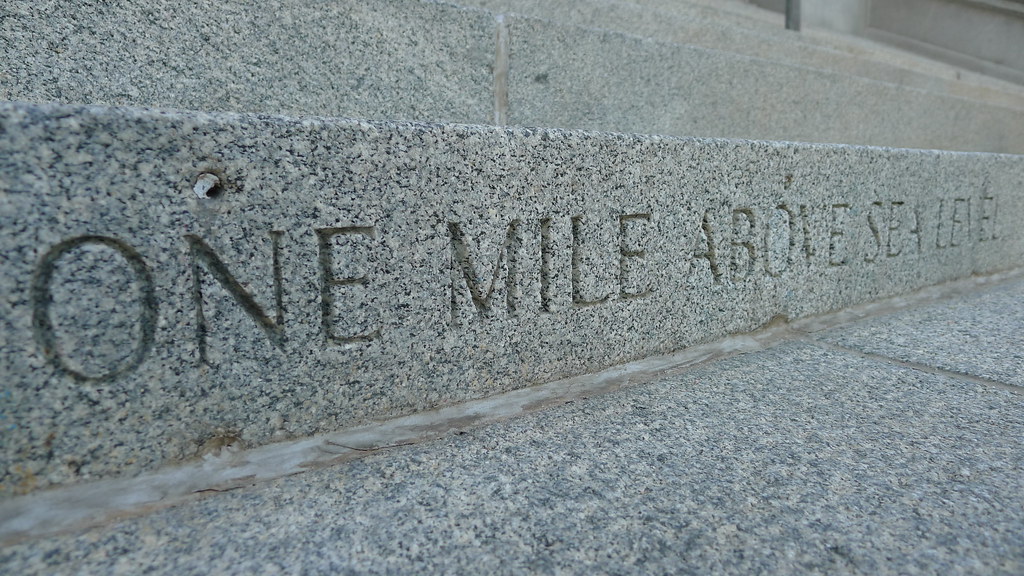I’ve returned from Denver, Colorado.
Well of course I found some time to record a couple of oddities. That’s what I do. Specifically I visited the Denver International Airport and one of the Arapahoe Exclaves. However, I didn’t exhaust the wish list I brought along with me. Maybe I should have expected that because I was a bit too ambitious. I didn’t have much time each evening and little flexibility with my schedule during the day.
So I thought I’d share one final big-ticket item I wanted to document in person. Unfortunately it will have to wait for a subsequent trip.
One Mile
Denver’s nickname is the “Mile High City” for an obvious reason. Look around and you’ll notice its elevation is indeed right around one mile or 5,280 feet (or 1,609 metres). This is quite evident as soon as an Eastern flatlander such as myself walks up a flight of steps on the day of arrival encumbered with luggage. I’d like to think of myself as being somewhat in shape and preferring to take the stairs for short distances. Even so, next time I’ll use the elevator until day two or three. It takes awhile for my brain to adjust to thinner oxygen at these higher altitudes.
I wanted to confirm Denver’s mile-high claim by examining evidence available on the ground. I’m not doubting their assertion because the altitude is completely self-evident. It’s not an exaggeration or a marketing ploy. Rather I wondered whether anyone had ever memorialized this exact height on the physical landscape. It’s such an interesting little tidbit. I figured the local tourist board must have put up a sign or a plaque to amuse the visitors.
The Search
I stared with a quick Google search on the phrase, “exactly one mile high.” That provided a good starting point with some solid candidates. Practically everything tracked back to Denver with the exception of a swinging bridge on Grandfather Mountain in North Carolina. I also wouldn’t mind visiting that someday but let’s get back on point. The difference is that in Denver everywhere is about a mile high, not just some out-of-the way park requiring a long drive and an admission fee.
Incidentally there are zero Google hits for “exactly one kilometer high”, and yes I do realize that I’ve just ruined that by publishing this post. I suppose this happens because a kilometre of elevation isn’t all that remarkable (3,281 feet). Or maybe this particular style of geo-oddity doesn’t resonate outside of the United States. Are there any armchair sociologists out there who want to offer an explanation or a theory? I have none.
However, there are at least two places in Denver — both easily accessible — that mark the mile-high elevation exactly and explicitly.
The State Capitol

The first location is the thirteenth step of the Colorado State Capitol building (map). I’m kicking myself for this one. I spent an entire week in downtown Denver a couple of years ago and didn’t realized this marker existed. It would have been so simple for me to record. This time I stayed way out in the suburbs. Unfortunately I didn’t have an easy way to get down there.
Coors Field

Another opportunity would have been available at Coors Field, home of the Colorado Rockies baseball team (map). The Rockies were in town, we had some beautiful weather, it would have been a great night for baseball. And again… I was way out in the ‘burbs.
The seats in the 20th row of the upper deck are purposely colored purple. This purple row creates a band around the stadium at the mile-high mark. This provides a more literal interpretation to the term “nosebleed section” than most of its major league counterparts.
Shifting Gears Just a Little
I noticed a peculiarity as I panned around the map of Denver while preparing this recent series of articles. Check this out:
Does anyone know of a smaller occupied area completely surrounded by Interstate highway? This triangle, probably no more than a mile on any side, is enclosed by Interstates 25, 76 and 270. There are plenty of paths in-and-out so it’s not exactly isolated but I still find it fascinating. I can’t imagine how noisy it must feel with those highways running so closely on every side. This patch is primarily non-residential (except for maybe these guys) which is probably a good thing.
I’d be interested to know if someone can find a smaller enclosed area where the space is actually being occupied, either for business or residential purposes, that doesn’t involve an instance of someone refusing to sell their property when the highway comes through, i.e., a planned route rather than an individual accommodation.

Leave a Reply